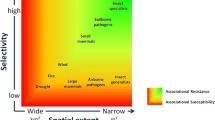Abstract
Prescribed burning currently is used to preserve endemicity of plant communities in remnant tallgrass prairies. Although some types of arthropods benefit from changes in plant communities brought about by burning, other species that are endemic to prairies may be threatened. Because they inhabit the ‘fuel layer’ of prairies, endophytic insects would seem particularly susceptible to this management tactic. In this paper, we assess the impact of prescribed burning on endophytic insect communities inhabiting stems of Silphium laciniatum L. and S. terebinthinaceum Jacquin (Asteraceae), endemic prairie plants. Populations of these insects were decimated by burning, with mortality approaching 100% in most cases. Their populations nevertheless began to rebound within a single growing season, with densities moderately but significantly reduced 1 year after the burn. Even when a prairie remnant was completely incinerated, plant stems were recolonized by insects within one growing season. Our findings suggest that sufficient numbers of endophytic insects survive burns in remains of Silphium to recolonize burned areas the following year.
Similar content being viewed by others
References
Arenz C.L. and Joern A. 1996. Prairie legacies-invertebrates. In: Samson F.B. and Knopf F.L. (eds) Prairie Conservation: Preserving North America's Most Endangered Ecosystem. Island Press, Washington, DC, pp. 91–110.
Beutenmüller W. 1910. The North American species of Aylax and their galls. Bulletin of the American Museum of Natural History 28: 137–144.
Clevinger J.A. and Panero J.L. 2000. Phylogenetic analysis of Silphium and subtribe Engelmanniinae (Asteraceae: Heliantheae) based on ITS and ETS sequence data. American Journal of Botany 87: 565–572.
Fay P.A. and Samenus Jr. R.J. 1993. Gall wasp (Hymenoptera: Cynipidae) mortality in a spring tallgrass prairie fire. Environmental Entomology 22: 1333–1337.
Gillette C.P. 1891. Descriptions of new Cynipidae in the collection of the Illinois State Laboratory of Natural History. Bulletin of the Illinois State Laboratory of Natural History 3: 191–197.
Gleason H.A. and Cronquist A. 1991. Manual of Vascular Plants of Northeastern United States and Adjacent Canada. 2nd ed.The New York Botanical Garden, The Bronx, New York.
ILENR 1994. The Changing Illinois Environment: Critical Trends, Summary Report of the Critical Trends Assessment Project. Vol. 3: Ecological Resources, ILENR/RE-EA-94/05. Illinois Department of Energy and Natural Resources, Springfield, Illinois.
Kosztarab M. and Schaefer C.W. 1990. Conclusions. In: Kosztarab M. and Schaefer C.W. (eds) Systematics of the North American Insects and Arachnids: Status and Needs. Virginia Agricultural Experiment Station Information Series 90-1. Blacksburg, Virginia, pp. 241–247.
Ladd D. 1997. Vascular plants of midwestern tallgrass prairies. In: Packard S. and Mutel C.F. (eds) The Tallgrass Restoration Handbook for Prairies, Savannas, andWoodlands. Island Press, Washington, DC, pp. 351–399.
McFall D. and Karnes J. (eds) 1995. A Directory of Illinois Nature Preserves. Vol. 1-2. Illinois Department of Natural Resources, Springfield, Illinois.
Meyer C.K., Whiles M.R. and Charlton R.E. 2002. Life history, secondary production, and ecosystem significance of acridid grasshoppers in annually burned and unburned tallgrass prairie. American Entomologist 48: 52–61.
Orwig T. and Schlicht D. 1999. The last of the Iowa skippers. American Butterflies 7: 4-12. Panzer R. 2002. Compatibility of prescribed burning with the conservation of insects in small, isolated prairie reserves. Conservation Biology 16: 1296–1307.
Pauly W.R. 1997. Conducting burns. In: Packard S. and Mutel C.F. (eds) The Tallgrass Restoration Handbook for Prairies, Savannas, and Woodlands. Island Press, Washington, DC, pp. 223–243.
Rice L.A. 1932. The effect of fire on the prairie animal communities. Ecology 13: 392–401.
Roberts M.L. and Cooperrider T.S. 1982. Dicotyledons. In: Cooperrider T.S. (ed) Endangered and Threatened Plants of Ohio, Ohio Biological Survey No. 16. Columbus, Ohio, pp. 48–84.
Samson F.B. and Knopf F.L. 1994. Prairie conservation in North America. BioScience 44: 418–421.
Samways M.J. 1994. Insect Conservation Biology. Chapman & Hall, London.
SAS Institute 2001. SAS/STAT User's Guide for Personal Computers, Release 8.01. SAS Institute, Cary, North Carolina.
Sokal R.R. and Rohlf F.J. 1995. Biometry, 3rd ed. W.H. Freeman, New York.
Steinauer E.M. and Collins S.L. 1996. Prairie ecology-the tallgrass prairie. In: Samson F.B. and Knopf F.L. (eds) Prairie Conservation: Preserving North America's Most Endangered Ecosystem. Island Press, Washington, DC, pp. 39–52.
Swengel A.B. 2001a. A literature review of insect responses to fire, compared to other conservation managements of open habitat. Biodiversity and Conservation 10: 1141–1169.
Swengel A.B. 2001b. Effects of prairie and barrens management on butterfly faunal composition. Biodiversity and Conservation 10: 1757–1785.
Taron D.J. 1997. Insects. In: Packard S. and Mutel C.F. (eds) The Tallgrass Restoration Handbook for Prairies, Savannas, and Woodlands. Island Press, Washington, DC, pp. 305–318.
Tooker J.F. and Hanks L.M. 2004. Endophytic insect communities of prairie perennials (Asteraceae: Silphium spp.) jeopardized by prescribed burning. Biodiversity and Conservation (in press).
Tooker J.F., Koenig W.A. and Hanks L.M. 2002. Altered host plant volatiles are proxies for sex pheromones in the gall wasp Antistrophus rufus. Proceedings of the National Academy of Science USA 99: 15486–15491.
Walter K.S. and Gillett H.J. (eds) 1998. 1997 IUCN Red List of Threatened Plants. Compiled by the World Conservation Monitoring Center. IUCN-The World Conservation Union, Gland, Switzerland and Cambridge, UK.
Weaver J.E. 1954. North American Prairie. Johnsen Publishing Co., Lincoln, Nebraska.
Williams A.H. 1999. Fauna overwintering in or on stems ofWisconsin prairie forbs. In: Springer J.T. (ed) Proceedings of the Sixteenth North American Prairie Conference, University of Nebraska, Kearney, Nebraska, pp. 157–161.
Rights and permissions
About this article
Cite this article
Tooker, J.F., Hanks, L.M. Impact of prescribed burning on endophytic insect communities of prairie perennials (Asteraceae: Silphium spp.). Biodiversity and Conservation 13, 1875–1888 (2004). https://doi.org/10.1023/B:BIOC.0000035872.24201.30
Issue Date:
DOI: https://doi.org/10.1023/B:BIOC.0000035872.24201.30




